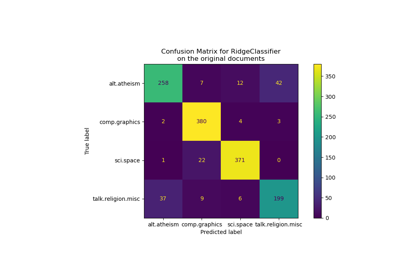sklearn.naive_bayes.ComplementNB¶
- class sklearn.naive_bayes.ComplementNB(*, alpha=1.0, force_alpha='warn', fit_prior=True, class_prior=None, norm=False)[source]¶
The Complement Naive Bayes classifier described in Rennie et al. (2003).
The Complement Naive Bayes classifier was designed to correct the “severe assumptions” made by the standard Multinomial Naive Bayes classifier. It is particularly suited for imbalanced data sets.
Read more in the User Guide.
New in version 0.20.
- Parameters:
- alphafloat or array-like of shape (n_features,), default=1.0
Additive (Laplace/Lidstone) smoothing parameter (set alpha=0 and force_alpha=True, for no smoothing).
- force_alphabool, default=False
If False and alpha is less than 1e-10, it will set alpha to 1e-10. If True, alpha will remain unchanged. This may cause numerical errors if alpha is too close to 0.
New in version 1.2.
Deprecated since version 1.2: The default value of
force_alphawill change toTruein v1.4.- fit_priorbool, default=True
Only used in edge case with a single class in the training set.
- class_priorarray-like of shape (n_classes,), default=None
Prior probabilities of the classes. Not used.
- normbool, default=False
Whether or not a second normalization of the weights is performed. The default behavior mirrors the implementations found in Mahout and Weka, which do not follow the full algorithm described in Table 9 of the paper.
- Attributes:
- class_count_ndarray of shape (n_classes,)
Number of samples encountered for each class during fitting. This value is weighted by the sample weight when provided.
- class_log_prior_ndarray of shape (n_classes,)
Smoothed empirical log probability for each class. Only used in edge case with a single class in the training set.
- classes_ndarray of shape (n_classes,)
Class labels known to the classifier
- feature_all_ndarray of shape (n_features,)
Number of samples encountered for each feature during fitting. This value is weighted by the sample weight when provided.
- feature_count_ndarray of shape (n_classes, n_features)
Number of samples encountered for each (class, feature) during fitting. This value is weighted by the sample weight when provided.
- feature_log_prob_ndarray of shape (n_classes, n_features)
Empirical weights for class complements.
- n_features_in_int
Number of features seen during fit.
New in version 0.24.
- feature_names_in_ndarray of shape (
n_features_in_,) Names of features seen during fit. Defined only when
Xhas feature names that are all strings.New in version 1.0.
See also
BernoulliNBNaive Bayes classifier for multivariate Bernoulli models.
CategoricalNBNaive Bayes classifier for categorical features.
GaussianNBGaussian Naive Bayes.
MultinomialNBNaive Bayes classifier for multinomial models.
References
Rennie, J. D., Shih, L., Teevan, J., & Karger, D. R. (2003). Tackling the poor assumptions of naive bayes text classifiers. In ICML (Vol. 3, pp. 616-623). https://people.csail.mit.edu/jrennie/papers/icml03-nb.pdf
Examples
>>> import numpy as np >>> rng = np.random.RandomState(1) >>> X = rng.randint(5, size=(6, 100)) >>> y = np.array([1, 2, 3, 4, 5, 6]) >>> from sklearn.naive_bayes import ComplementNB >>> clf = ComplementNB(force_alpha=True) >>> clf.fit(X, y) ComplementNB(force_alpha=True) >>> print(clf.predict(X[2:3])) [3]
Methods
fit(X, y[, sample_weight])Fit Naive Bayes classifier according to X, y.
get_params([deep])Get parameters for this estimator.
partial_fit(X, y[, classes, sample_weight])Incremental fit on a batch of samples.
predict(X)Perform classification on an array of test vectors X.
Return joint log probability estimates for the test vector X.
Return log-probability estimates for the test vector X.
Return probability estimates for the test vector X.
score(X, y[, sample_weight])Return the mean accuracy on the given test data and labels.
set_params(**params)Set the parameters of this estimator.
- fit(X, y, sample_weight=None)[source]¶
Fit Naive Bayes classifier according to X, y.
- Parameters:
- X{array-like, sparse matrix} of shape (n_samples, n_features)
Training vectors, where
n_samplesis the number of samples andn_featuresis the number of features.- yarray-like of shape (n_samples,)
Target values.
- sample_weightarray-like of shape (n_samples,), default=None
Weights applied to individual samples (1. for unweighted).
- Returns:
- selfobject
Returns the instance itself.
- get_params(deep=True)[source]¶
Get parameters for this estimator.
- Parameters:
- deepbool, default=True
If True, will return the parameters for this estimator and contained subobjects that are estimators.
- Returns:
- paramsdict
Parameter names mapped to their values.
- partial_fit(X, y, classes=None, sample_weight=None)[source]¶
Incremental fit on a batch of samples.
This method is expected to be called several times consecutively on different chunks of a dataset so as to implement out-of-core or online learning.
This is especially useful when the whole dataset is too big to fit in memory at once.
This method has some performance overhead hence it is better to call partial_fit on chunks of data that are as large as possible (as long as fitting in the memory budget) to hide the overhead.
- Parameters:
- X{array-like, sparse matrix} of shape (n_samples, n_features)
Training vectors, where
n_samplesis the number of samples andn_featuresis the number of features.- yarray-like of shape (n_samples,)
Target values.
- classesarray-like of shape (n_classes,), default=None
List of all the classes that can possibly appear in the y vector.
Must be provided at the first call to partial_fit, can be omitted in subsequent calls.
- sample_weightarray-like of shape (n_samples,), default=None
Weights applied to individual samples (1. for unweighted).
- Returns:
- selfobject
Returns the instance itself.
- predict(X)[source]¶
Perform classification on an array of test vectors X.
- Parameters:
- Xarray-like of shape (n_samples, n_features)
The input samples.
- Returns:
- Cndarray of shape (n_samples,)
Predicted target values for X.
- predict_joint_log_proba(X)[source]¶
Return joint log probability estimates for the test vector X.
For each row x of X and class y, the joint log probability is given by
log P(x, y) = log P(y) + log P(x|y),wherelog P(y)is the class prior probability andlog P(x|y)is the class-conditional probability.- Parameters:
- Xarray-like of shape (n_samples, n_features)
The input samples.
- Returns:
- Cndarray of shape (n_samples, n_classes)
Returns the joint log-probability of the samples for each class in the model. The columns correspond to the classes in sorted order, as they appear in the attribute classes_.
- predict_log_proba(X)[source]¶
Return log-probability estimates for the test vector X.
- Parameters:
- Xarray-like of shape (n_samples, n_features)
The input samples.
- Returns:
- Carray-like of shape (n_samples, n_classes)
Returns the log-probability of the samples for each class in the model. The columns correspond to the classes in sorted order, as they appear in the attribute classes_.
- predict_proba(X)[source]¶
Return probability estimates for the test vector X.
- Parameters:
- Xarray-like of shape (n_samples, n_features)
The input samples.
- Returns:
- Carray-like of shape (n_samples, n_classes)
Returns the probability of the samples for each class in the model. The columns correspond to the classes in sorted order, as they appear in the attribute classes_.
- score(X, y, sample_weight=None)[source]¶
Return the mean accuracy on the given test data and labels.
In multi-label classification, this is the subset accuracy which is a harsh metric since you require for each sample that each label set be correctly predicted.
- Parameters:
- Xarray-like of shape (n_samples, n_features)
Test samples.
- yarray-like of shape (n_samples,) or (n_samples, n_outputs)
True labels for
X.- sample_weightarray-like of shape (n_samples,), default=None
Sample weights.
- Returns:
- scorefloat
Mean accuracy of
self.predict(X)w.r.t.y.
- set_params(**params)[source]¶
Set the parameters of this estimator.
The method works on simple estimators as well as on nested objects (such as
Pipeline). The latter have parameters of the form<component>__<parameter>so that it’s possible to update each component of a nested object.- Parameters:
- **paramsdict
Estimator parameters.
- Returns:
- selfestimator instance
Estimator instance.
Examples using sklearn.naive_bayes.ComplementNB¶

Sample pipeline for text feature extraction and evaluation

Classification of text documents using sparse features